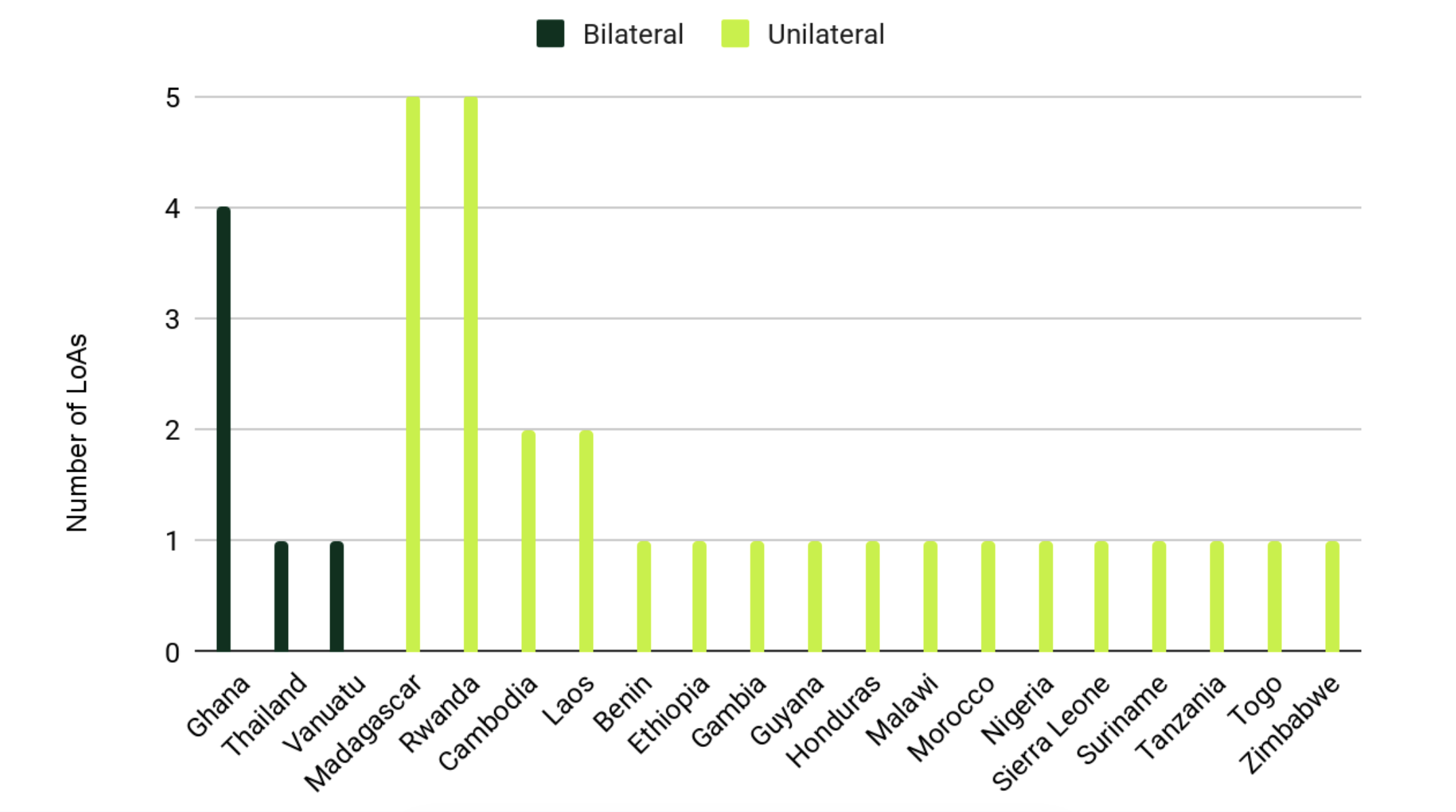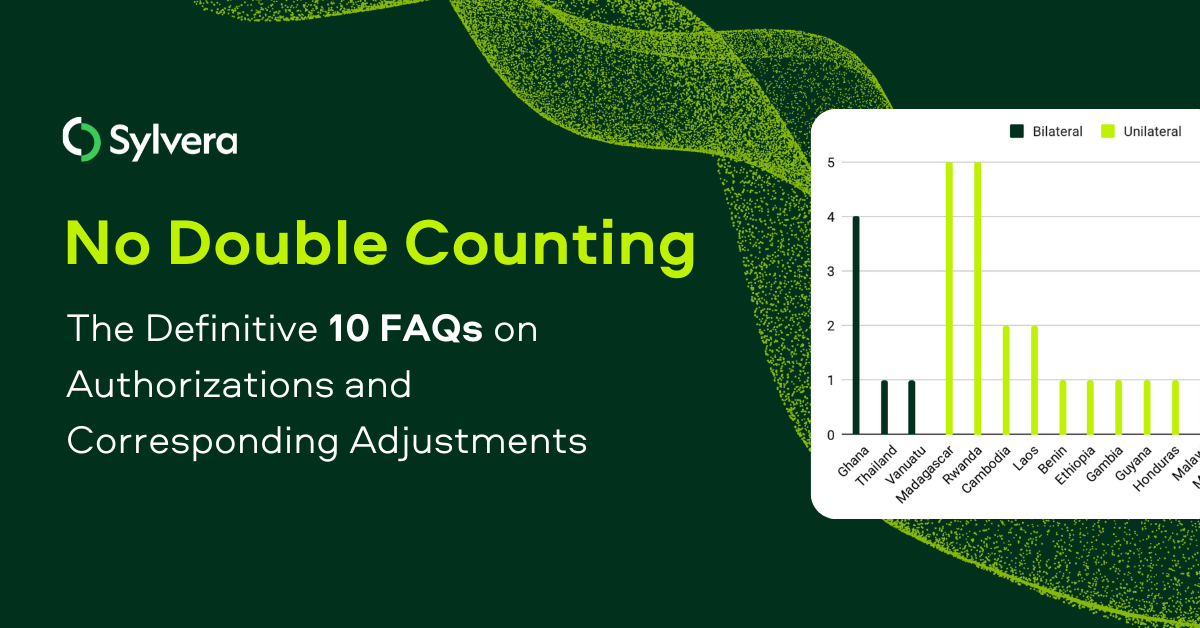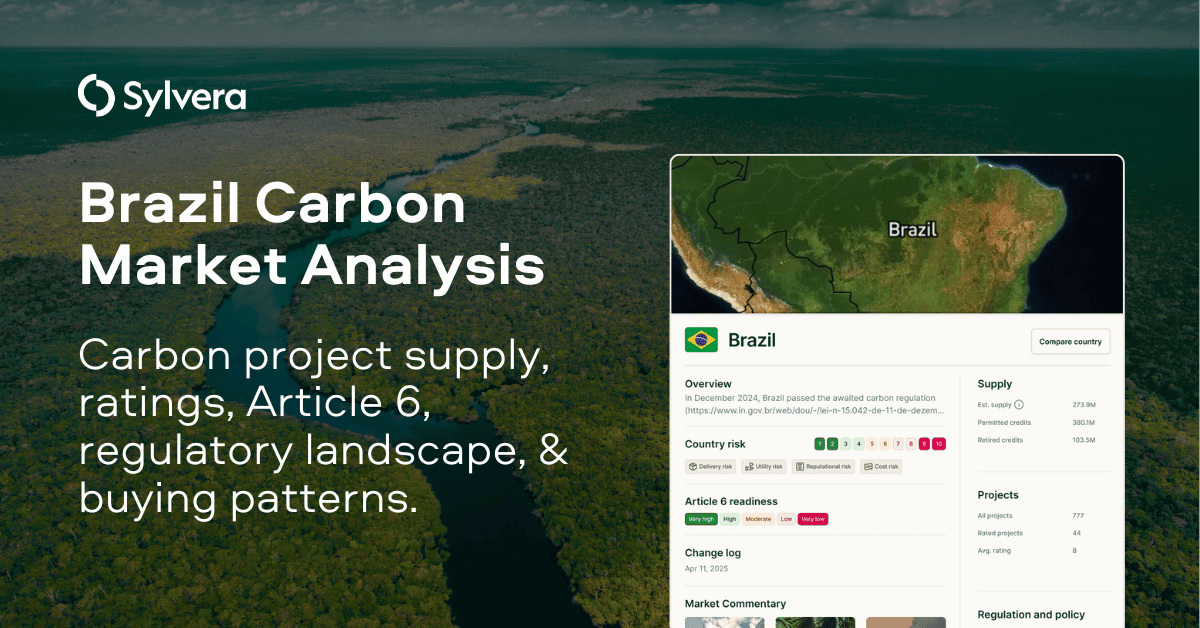“Over the years we’ve invested significantly in our field data team - focusing on producing trusted ratings. While this ensures the accuracy of our Ratings, it doesn’t allow the scale across the thousands of projects that buyers are considering.”
For more information on carbon credit procurement trends, read our "Key Takeaways for 2025" article. We share five, data-backed tips to improve your procurement strategy.

One more thing: Connect to Supply customers also get access to the rest of Sylvera's tools. That means you can easily see project ratings and evaluate an individual project's strengths, procure quality carbon credits, and even monitor project activity (particularly if you’ve invested at the pre-issuance stage.)
Book a free demo of Sylvera to see our platform's procurement and reporting features in action.
What determines a carbon credit’s usability for a compliance carbon market? One of the most important filters for a carbon credit is now the status of its authorization based on guidance under the Paris Agreement’s Article 6.2, followed by a host country’s application of a Corresponding Adjustment, and potentially the provision of insurance to cover for non-adjustment risk. These steps can have implications for credit price and a host country’s reporting requirements, and determine the carbon markets the credit can be used in.
Under Article 6.2 of the Paris Agreement, the seemingly complex mechanisms of Letters of Authorization (LoAs) and Corresponding Adjustments (CAs) serve a singular, crucial purpose: preventing the dreaded double-counting of emissions reductions. These guardrails carry significant financial and strategic implications across carbon markets.
This FAQ breakdown will clarify the essentials for:
- Project developers: These rules dictate the compliance carbon markets your credits could access, and their potential value.
- Investors: They determine the fungibility and scope of the long-term demand pool for your climate assets.
- Buyers: They determine credit eligibility for international compliance (e.g., CORSIA, Paris Agreement targets) and some domestic compliance carbon markets (e.g., Singapore).
1. What are Corresponding Adjustments (CAs) and Letters of Authorization (LoAs)?
- CA: an accounting measure under Article 6 of the Paris Agreement through which the host country transfers an Internationally Transferred Mitigation Outcome (ITMO) by adding the MO (mitigation outcome, i.e. emission reductions/removals) back into its total emissions—to avoid counting the MO toward its Paris target(s). If the acquiring entity is a country (obtaining ITMOs directly or through some regulation of private entities), it subtracts the MOs from its own national total emissions. Please note this measure only applied to credits of 2021+ vintage.
- LoA: a formal letter issued by the host country that authorizes the international transfer of MOs and commits to applying the CA for the volume of MOs quantified or described in that letter.

2. When are LoAs and CAs required under Article 6?
3. How do LoAs and CAs impact the quality of a carbon credit?
- Integrity: LoAs and CAs function purely as accounting mechanisms. Their purpose is to prevent the double-claiming of a MO when a carbon credit is authorized for use toward a compliance target other than the host country’s own NDC (e.g., another Party’s NDC, CORSIA). Hence, the application of a CA does not affect the quality of the project itself (e.g., its additionality, permanence).
- Voluntary purchases: for credits purchased for purely voluntary claims (i.e., not for NDC compliance or a specific international scheme like CORSIA), a CA is not required. The credit's value and quality in the voluntary market are independent of the Paris Agreement's accounting system; they are based on the quality and nature of the underlying certification methods and of the activity itself. Some credits purchased and used for voluntary purposes are from the same projects, using the same standards and methodologies, that are eligible to supply compliance markets or that have been formally recognized by national governments. A credit used for a voluntary claim is not of worse quality for lacking a CA; it is simply not fully usable in international compliance frameworks.
4. When is the CA considered applied?
- Trigger: the CA is applied for the volume of ITMOs that fall within the scope of an LoA, but only after the credits trigger the host country’s condition(s) for being counted as first transfers. These first transfer triggers are not clearly defined or standardized and must be specified by the host country in its LoA.
- Example: If a host country indicates that issuance is its accounting trigger, the country would tally up any qualifying credits that are issued in a given year and annually report these volumes (as first-transfers!) by mid-April of the next year. Every two years, through their Biennial Transparency Reports (BTRs), the host country applies CAs to account for these first-transferred volumes. Authorization or use/cancellation are two other common first-transfer triggers.
- Reporting time gap: due to the biennial nature of BTRs—for which some developing countries may invoke needed reporting flexibilities and make delayed submissions—significant time gaps can occur between the credit's initial qualification for accounting and when it is reported as a first transfer; and then when a CA is reported.
- CA application: only when the final, necessary reporting of the CA is reflected in the host country's GHG emission balance in its public BTR submission can the CA be considered applied.
5. What is the current global status of LoAs and CAs?
- Host country limitations: many host countries face significant challenges with Article 6.2 readiness and capacity
- (e.g., any national registry development, legal frameworks, or market or inventory analysis needed). Many are also cautious, fearing the risk of over-committing (often referred to as overselling) their available mitigation potential and putting the achievement of their NDC at risk. There are various ways that host countries are seeking to deal with this risk.
- LoAs: at the time of writing a very limited number of LoAs have been formally reported—either as part of a bilateral agreement (with an identified buyer) or through unilateral host country reporting (where the buyer is undisclosed or unconstrained).
- CAs: although some first transfers of authorized credits have occurred, Guyana, Zimbabwe, and Malawi are currently the only countries that have formally reported the CA application to the UNFCCC, thus completing the full accounting cycle.

*The numbers reflect submitted LoAs. A thorough assessment of requirements compliance and appropriate agency submission has not been performed.
6. What is LoA revocation risk, and how can it be mitigated?
- Risk: the risk that a host country fails to apply the CA as indicated in the LoA, effectively revoking the utility of the credit for compliance buyers.
- Impact: if a CA is revoked or not applied, credits lose their utility for buyers that need a CA, such as:
- Countries purchasing for their NDCs;
- Compliance buyers using international credits for compliance with a domestic regulation and potentially NDC achievement (e.g., for Singapore's carbon tax);
- Compliance buyers using credits for other international mitigation purposes (CORSIA).
- Tackling the risk: to provide a crucial safeguard for credit utility, the Article 6 rulebook (as concluded at COP29 in Baku) stipulates that a host country cannot unilaterally revoke authorization after the first international transfer, unless the terms and conditions of the LoA explicitly reserved that right. This specific risk, as well as the risk of revocation by omission (i.e., non-reporting by the host country), is also mitigated by risk mitigation measures, such as available insurance products, buffer credit replacement pools, or limiting eligibility to credits for which adjustments have already been applied—each of which are recognized for compliance under CORSIA.
7. What are the typical costs associated with obtaining LoAs and CAs?
- Fees: host countries may introduce an administrative fee for issuing the LoA and applying CAs. This fee can vary significantly by country and many have not defined any fee.
- Opportunity cost: a significant cost may be the opportunity cost to the host country associated with transferring the MO, rather than counting it toward its own NDC. The host country forgoes counting that specific emissions reduction towards its own NDC and, depending on the stringency of the NDC, may need to find additional policy avenues to achieve additional emissions reductions from other sources. This risk is also weighed against the possibility that projects may be less likely to be located in countries that are unwilling to authorize some portion of their outcomes/credits—countries must closely consider these trade-offs.
- Carrying cost: project developers /credit suppliers may similarly compare the cost of holding onto credits for the long and uncertain timeframes linked to LoAs (to transact at potentially premium credit prices) to the simpler option of executing transactions comparably quickly at lower but still-acceptable prices in markets that do not require CAs.
8. How are LoAs and CAs formally documented and reported?
- Issuing agency: an authorized government entity in the host country, often the Designated National Authority (DNA), is responsible for publishing or conveying the LoA. The CA is documented—at least every two years—in the host country’s reporting on progress made toward its Paris Agreement emissions targets.
- Content/template: while a specific template is not mandated, LoAs must contain key elements (such as project details, volume, vintage, LoA timeframe, eligible use—e.g., NDC, CORSIA—and the commitment to apply the CA). The UNFCCC, some carbon standards and others in the market provide non-mandatory templates for guidance.
- Reporting: a country’s publication of an LoA triggers the country to submit an Initial Report to the UNFCCC that details the LoA and the activities and MOs that underpin it. The LoA must be submitted with that report—and any subsequent LoAs submitted with Updated Initial Report(s)—as soon as possible upon being finalized. Given the newness of this requirement, you might find LoAs in the UNFCCC portal, on acquiring and/or host countries' dedicated websites, and/or in registries together with other project documentation. Any countries involved are required to report detailed annual information on the MOs transferred under the authorization. This data is aggregated into amounts that are correspondingly adjusted; the application of the CA is reported to the UNFCCC by countries as part of their Biennial Transparency Reports (BTRs).
9. What is the role of national registries in managing LoAs and CAs?
- Host country tools: National registries are emerging as the central infrastructural tool host countries use to track domestic carbon projects, LoAs and CAs.
- Transparency: by centralizing the data on issuance, transfer, and adjustments, registries ensure transparent tracking of all activities and credits associated with ITMOs, which is critical for building trust between trading partners and meeting the transparency requirements of the Paris Agreement.
- Positive list: listing a project in the national registry can be a mandatory requirement to receive a LoA and subsequently, a CA. Some national registries enforce eligibility requirements for listing, thereby signaling the types of MOs the host country is willing to authorize for international transfer.
10. How are leading carbon standards labeling CA-eligible credits?
- Lack of alignment: currently, there is no single, standardized approach or aligned labeling system across all independent carbon standards.
- Standard-specific labeling: carbon standards (e.g., ACR, ART TREES, Gold Standard, Verra) have developed its own specific labeling system or attribute tags to indicate if a project’s credits are eligible for a CA, also any authorized uses, and/or if a CA has been applied.
Want to learn more?
Track LoAs and CAs: use the dedicated tag in the Sylvera catalog to track LoAs and CAs. You can try the free access version of the platform if you’re not already a user.
Deep dive into Article 6: read Sylvera’s Article 6 e-book for a comprehensive understanding of the policy and market implications.
Learn more about Article 6 readiness: check out Sylvera’s report, co-authored with CACE, providing a blueprint for host countries Article 6 readiness.















